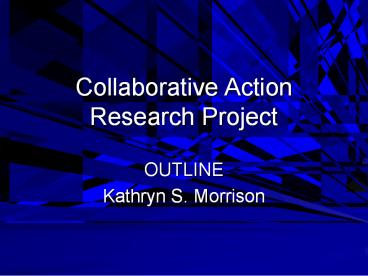Collaborative Action Research Project - PowerPoint PPT Presentation
Title:
Collaborative Action Research Project
Description:
Second grade students are failing to use proper spelling when adding suffixes to ... falls well short of their receptive abilities (Windsor, J. and Whang, M., 1999) ... – PowerPoint PPT presentation
Number of Views:177
Avg rating:3.0/5.0
Title: Collaborative Action Research Project
1
Collaborative Action Research Project
- OUTLINE
- Kathryn S. Morrison
2
Improving Spelling Errors of Second Grade
Students When Adding Suffixes to Root Words
3
Chapter I. Introduction
- Problem Statement
- Purpose of Study
- Description of Community
- Description of Work Setting
- Writers Role in Work Setting
4
PROBLEM STATEMENT
- Second grade students are failing to use proper
spelling when adding suffixes to words.
5
PURPOSE of STUDY
- determine some causes for this problem
- develop a strategy for improving the situation
6
DESCRIPTION of COMMUNITY
- Public school system in urban Southeastern US
- District comprised of
- 31 Elementary
- 5 Middle Schools
- 5 High Schools
7
Description of Community(continued)
- Enrollment of 25,000 in a community of 250,000
- A large portion of affluent and middle class
students attend area private schools - leaving predominately lower socio- economic
children in public system
8
DESCRIPTION ofWORK SETTING
- At-Risk Elementary School
- 95 students qualify for free lunch
- 25 qualify for special education
- 12 retention in same grade
9
Work Setting (continued)
- Total student population 380
- 99 African American
- 1 Anglo American
- Awarded State School of Excellence
- High degree of reciprocal community involvement
10
WRITERS ROLE
- Writer is School Music Specialist
- Teaching responsibilities
- general music - all students grades 1-3
- playing of instruments - all students grade 4
- choir - auditioned students grades 4-6
11
(No Transcript)
12
Chapter II. Study of the Problem
13
Chapter II. Study of the Problem
- Problem Description
- Problem Documentation
- Literature Review
- Causative Analysis
14
PROBLEM DESCRIPTION
- Second grade students are failing to use proper
spelling when adding suffixes to words - Students do not know rules for adding suffixes
- Students cannot apply rules when they are given
- Students lack motivation to improve
15
PROBLEM DOCUMENTATION
- Second grade teachers report student spelling
errors when adding suffixes to words - 13 of 17 students make 4 or more errors on
spelling test when adding suffixes - 15 of 17 students make multiple errors on
suffixes in journal writing - Only 1 of 17 students verbalize rules accurately
16
LITERATURE REVIEW
- English spelling has traditionally been difficult
for those who teach it as well as those who must
learn it (Johnston, 2000 )
17
Literature Review (continued)
- Students who have been unable to intuitively
grasp rules of English structure benefit from
introduction to and more structured work with
generalizations (Abbott, M. 2000)
18
Literature Review (continued)
- School-age students identify the meanings of
familiar suffixes with fairly high levels of
accuracy but their ability to produce these same
suffixes falls well short of their receptive
abilities (Windsor, J. and Whang, M., 1999).
19
CAUSATIVE ANALYSIS
- Second grade students lack
- a tool for memorization of general rules
- the ability to apply generalized rules
- motivation to improve
20
(No Transcript)
21
Chapter III. Outcomes and Evaluations
22
Chapter III. Outcomes and Evaluations
- Goals and Expectations
- Expected Outcomes
- Measurement of Outcomes
- Analysis of Results
23
GOALS and EXPECTATIONS
- Second grade students will use proper spelling
when adding suffixes to words
24
EXPECTED OUTCOMES
- Three specific outcomes will be achieved
- 10 of 17 students will make less than 4 errors on
post intervention spelling test
Pre Intervention
Post Intervention
Number of Participants
25
EXPECTED OUTCOMES
- Three specific outcomes will be achieved
- 10 of 17 students will make 1 or less errors per
paragraph on journal entries
Pre Intervention
Post Intervention
Number of Participants
26
EXPECTED OUTCOMES
- Three specific outcomes will be achieved
- 15 of 17 students will accurately verbalize
generalized spelling rules for the addition of
suffixes
Pre Intervention
Post Intervention
Number of Participants
27
MEASUREMENT of OUTCOMES
- Four types of quantitative evaluations
- Pre and post implementation spelling tests scores
- Pre and post implementation journal assignments
scores - Oral recitation of generalized rules scores
- Comparison of study group to control group both
pre and post implementation
28
ANALYSIS of RESULTS
- Analysis will be shown in bar graph form
- A t-test at the .05 level of significance will be
employed
29
(No Transcript)
30
Chapter IV. Solution Strategy
31
Chapter IV. Solution Strategy
- Statement of Problem
- Discussion
- Description of Selected Solutions
32
STATEMENT of PROBLEM
- One of the major spelling difficulties
experienced by second grade students is in
attempting to add suffixes to root words,
particularly when the root spelling changes with
the addition of the suffix.
33
DISCUSSION
- Several factors to consider through which the
writer can effect change - Flexibility based on student development is key
(Abbott, 2000) - Music shares brain processes with language
(Hodges, 2000)
34
Discussion (Continued)
- Musical activities build neural bridges used for
spatial reasoning (Rayl, 1995) - Music aids recall (Murphey, 2001)
35
DESCRIPTION of SELECTED SOLUTIONS
- Steps in intervention
- Music Specialist will teach rules set to music
- Classroom teacher will play recording of rules
set to music - Remedial students will be given a copy of the
recording to use at home
36
CONCLUSION
- The use of music to teach general rules in
spelling - adds flexibility to traditional approaches
- aids memorization
- stimulates language skills
- strengthens spatial reasoning
- motivates improvement
37
MUSIC MOVES US!





















![Research on Stem Cells Transplantation in Oncology - Pipeline Insights [2015] PowerPoint PPT Presentation](https://s3.amazonaws.com/images.powershow.com/8305427.th0.jpg?_=201511240612)









